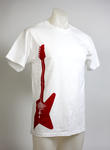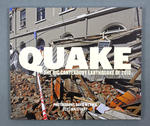Search
Photograph by Paul Corliss 1565
Images, UC QuakeStudies
A photograph of the earthquake damage to a house on Major Hornbrook Drive. The chimney has collapsed and many of the tiles have been lifted on the roof. Tarpaulins have been laid over the holes in the roof as waterproofing, but the closest has shredded. Gaps can be seen between the bricks in the wall and the wall to the left has crumbled.
22 February Earthquake - Photograph 23
Images, UC QuakeStudies
Two people examine damage to a house in Richmond. The brick wall is badly cracked and twisted, and some bricks have fallen, exposing the lining paper and framing below. The photographer comments, "These photos show our old house in River Rd and recovery work around Richmond and St Albans. The near wall is leaning at an alarming angle. I didn't like walking past it".
Photograph by Neil Macbeth 393
Images, UC QuakeStudies
USCA President, Kohan McNab, and leader of the Student Volunteer Army, Sam Johnston, on top of the ENSOC fire engine. Behind them, students from the University of Canterbury are enjoying a barbeque lunch break. The students have volunteered to dig up liquefaction as part of the Student Volunteer Army.
New Zealand Defence Force photograph 684
Images, UC QuakeStudies
Damaged buildings along London Street. Wire fencing has been used to keep people away. To the left is the Volcano Cafe, centre the Lava Bar and on the right is a fish and chip shop. A pile of rubble lies on the street from the damaged buildings.
Jim Baltaxe WEMO Photograph 063
Images, UC QuakeStudies
A photograph of road works on a residential street in Christchurch. Two workers in high-visibility vests can be seen, one setting up road cones. A digger is sitting on a pile of dug up gravel and earth. Cordon fences have been placed around the site. In the distance, a dump truck can be seen.
Bettina Evans's photograph 29
Images, UC QuakeStudies
A member of the Lyttelton community who was given a felt heart. The felt hearts were a healing outlet during the Canterbury earthquakes. The goal was to create beauty in the midst of chaos, to keep people's hands busy and their minds off the terrifying reality of the earthquakes, as well as to give a gift of love to workers and businesses who helped improve life in Lyttelton.
Dan Neely WEMO Photograph 12
Images, UC QuakeStudies
A photograph of the earthquake damage to a building in Lyttelton. The brick wall has crumbled and the bricks have spilt onto the pavement below. The pink batts are now exposed and the remaining wall is severely cracked. Wire fencing and tape reading "danger keep out" has been placed around the building as a cordon.
Bettina Evans's photograph 32
Images, UC QuakeStudies
A member of the Lyttelton community who was given a felt heart. The felt hearts were a healing outlet during the Canterbury earthquakes. The goal was to create beauty in the midst of chaos, to keep people's hands busy and their minds off the terrifying reality of the earthquakes, as well as to give a gift of love to workers and businesses who helped improve life in Lyttelton.
22 February Earthquake - Photograph 20
Images, UC QuakeStudies
Damage to a house in Richmond. The brick wall is badly cracked and twisted, and some bricks have fallen, exposing the lining paper and framing below. The driveway is cracked and covered in liquefaction. The photographer comments, "These photos show our old house in River Rd and recovery work around Richmond and St Albans. More shaking damage on the east wall of the living room at our house".
22 February Earthquake - Photograph 35
Images, UC QuakeStudies
A group of residents stand talking on the footpath beside River Road. The photographer comments, "Our neighbours were mostly already displaced by the Sep 4 2010 quakes. We all happened to arrive at the same time, so we had a good chat. From L-R; Deidre Crichton (389), Julie and Philip Cheyne (391), Marike Begg (363), Susannah and Kim Collins (383), Andy Corbin (389)".
NZi3 - Temporary HQ - Photograph 19
Images, UC QuakeStudies
Members of the University of Canterbury's E-Learning team, Jess Hollis, Alan Hoskin, Paul Nicholls and Susan Tull, in their temporary office in the NZi3 building. The photographer comments, "University of Canterbury administration all fits into one building! Well, sort of. Jess with laptop on side desk, Paul the same on the other side, Susan getting sorted, Alan on the phone. Another day in the e-learning corner".
Photograph by Neil Macbeth 005
Images, UC QuakeStudies
A powhiri performed by Ngai Tahu elders to welcome workers of the Stronger Christchurch Infrastructure Rebuild Team (SCIRT). Mayor Bob Parker is standing to the right. Reverend Peter Beck and Earthquake Minister Gerry Brownlee are also present. The ceremony was held in Burwood Park.
Bettina Evans's photograph 38
Images, UC QuakeStudies
A member of the Lyttelton community who was given a felt heart outside the library. The felt hearts were a healing outlet during the Canterbury earthquakes. The goal was to create beauty in the midst of chaos, to keep people's hands busy and their minds off the terrifying reality of the earthquakes, as well as to give a gift of love to workers and businesses who helped improve life in Lyttelton.
US Embassy Photograph 15
Images, UC QuakeStudies
Members of the USAID Disaster Assistance Response Team and New Zealand Urban Search and Rescue Team in front of a collapsed house in the Christchurch central city. In the background, the Newstalk ZB Building can be seen.

Lunch Bag: Rechurch
Images, Canterbury Museum
One expandable oblong brown fabric bag produced by Christchurch church group Rechurch; black and green writing on the front and back. Used to deliver lunch to Student Volunteer Army clean up parties after the 4 September 2010 earthquake. This reusable fabric bag from the church group Rechurch, Christchurch was used to deliver lunches to the stu...

Dust Mask: 3M
Images, Canterbury Museum
One white dust mask with elastic strap to secure around the head. Black printing on the front reads: '3M 8000 / P1 / AS/NZS 1716'. Used by Student Volunteer Army in the clean up after 4 September 2010 earthquake. Face masks were recommended by Christchurch Public Health staff as a safety precaution for those handling liquefaction. Liquefaction ...

Wheelbarrow: Kelso
Images, Canterbury Museum
One black plastic barrelled wheelbarrow with a blue metal frame, black rubber handles and a pneumatic tyre; manufacturer's name in white on long sides and torn promotional label on short side near handles. Barrel is well used and contains remnants of liquefaction. Used by Student Volunteer Army in the clean up after 4 September 2010 earthquake. ...

T-shirt: Band Together Concert for Canterbury
Images, Canterbury Museum
One white cotton t-shirt with red printed guitar logo on front and ‘Band / Together / Concert / for / Canterbury // 23rd October / Hagley Park’ in black and red writing, guitar logo and names of performers on the reverse. This concert was a free morale booster following the 4 September 2010 earthquake. The 4 September 2010 earthquake unsettled ...

Book: Quake, the Big Canterbury Earthquake of 2010
Images, Canterbury Museum
One multi-coloured soft-cover book entitled 'Quake: the Big Canterbury Earthquake of 2010' with colour photographs by David Wethey and text by Ian Stuart. ‘Quake: The Big Canterbury Earthquake of 2010’ contains aerial photographs of the damage to many major heritage sites in Canterbury between Kaiapoi and Darfield after the 4 September 2010 ear...

Christchurch, NZ - Cashel Mall Restart
Images, eqnz.chch.2010
The CBD is slowly being opened up and this is the post - earthquake result of Cashel Mall. A vibrant, fresh look with high end shopping in colourful container shops. A really good step forward for the city.

Christchurch, NZ - Cashel Mall Restart
Images, eqnz.chch.2010
The CBD is slowly being opened up and this is the post - earthquake result of Cashel Mall. A vibrant, fresh look with high end shopping in colourful container shops. A really good step forward for the city.

Christchurch, NZ - Cashel Mall Restart
Images, eqnz.chch.2010
The CBD is slowly being opened up and this is the post - earthquake result of Cashel Mall. A vibrant, fresh look with high end shopping in colourful container shops. A really good step forward for the city.

Christchurch, NZ - Cashel Mall Restart
Images, eqnz.chch.2010
The CBD is slowly being opened up and this is the post - earthquake result of Cashel Mall. A vibrant, fresh look with high end shopping in colourful container shops. A really good step forward for the city.

Christchurch, NZ - Cashel Mall Restart
Images, eqnz.chch.2010
The CBD is slowly being opened up and this is the post - earthquake result of Cashel Mall. A vibrant, fresh look with high end shopping in colourful container shops. A really good step forward for the city.

Christchurch, NZ - Cashel Mall Restart
Images, eqnz.chch.2010
The CBD is slowly being opened up and this is the post - earthquake result of Cashel Mall. A vibrant, fresh look with high end shopping in colourful container shops. A really good step forward for the city.
Plato Creative Photograph 14
Images, UC QuakeStudies
The Cranmer Court building, on the corner of Kilmore and Montreal Streets, after the 22 February 2011 earthquake. Large pieces of the building have collapsed, including the octagonal corner section that housed Plato Creative from March 2008 to November 2009. Masonry has fallen onto the footpath and road, and the site has been enclosed in a safety fence to keep people away. The whitewashed interior walls of one of the apartments can be seen.
Photographic Services Photograph 09
Images, UC QuakeStudies
A photograph of Graeme Kershaw, Technician at the University of Canterbury Department of Physics and Astronomy, looking through the lens of the Townsend Telescope. The lens is the most crucial component of the telescope. It was found unscratched and unbroken in the rubble of the Observatory tower, after 22 February 2011 earthquake. This means that the telescope can be restored. Other parts of the earthquake-damaged telescope are in the background of the photograph.
Photographic Services Photograph 10
Images, UC QuakeStudies
A photograph of Graeme Kershaw, Technician at the University of Canterbury Department of Physics and Astronomy, looking through the lens of the Townsend Telescope. The lens is the most crucial component of the telescope. It was found unscratched and unbroken in the rubble of the Observatory tower, after 22 February 2011 earthquake. This means that the telescope can be restored. Other parts of the earthquake-damaged telescope are in the background of the photograph.
Photograph by Jocelyn Kinghorn 2671
Images, UC QuakeStudies
A information board on the fence around the Homestead at Mona Vale. It says 'This hertiage building is managed by the Christchurch City Council on behalf of the city's residents. Until recently it served as a restaurant and function centre. This building was damaged in the 2010/2011 Canterbury earthquakes and ongoing aftershocks. Propping walls and other support is designed to keep the building weather-proof until a decision about its future can be made'.
ELM Offices Level 7 Library - Photograph 18
Images, UC QuakeStudies
Furniture and equipment packed up ready for the University of Canterbury's E-Learning team's move to their temporary office in the James Hight building. The photographer comments, "First looks at our new temporary (maybe) office space. Our group will stay here until April or May 2011, then will move to another floor in the Central Library. Waiting for the movers. Our office is packed into orange crates, everything is labelled, where are the movers?".
